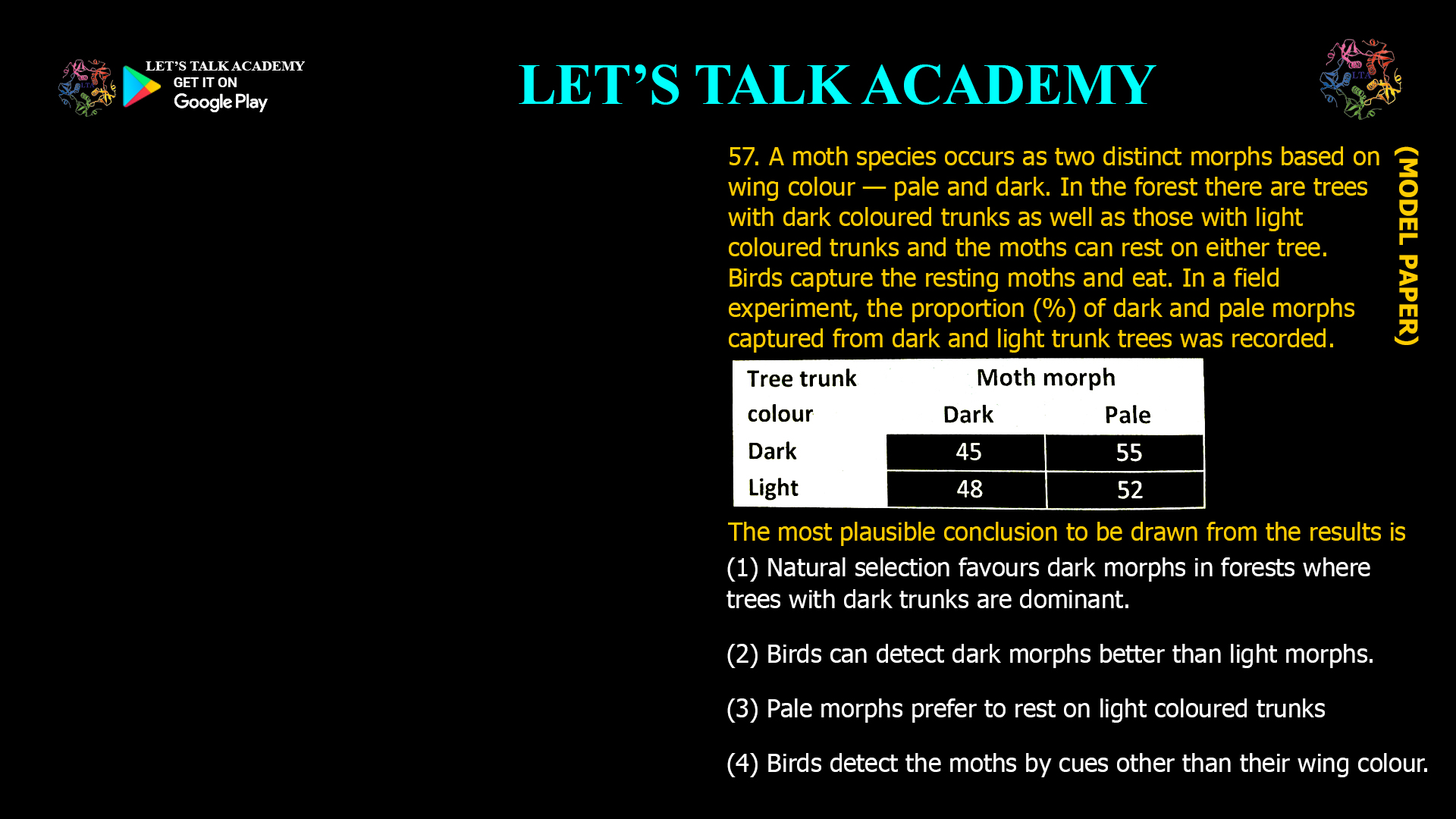- A moth species occurs as two distinct morphs based on wing colour — pale and dark. In the forest there are trees with dark coloured trunks as well as those with light coloured trunks and the moths can rest on either tree. Birds capture the resting moths and eat. In a field experiment, the proportion (%) of dark and pale morphs captured from dark and light trunk trees was recorded.
The most plausible conclusion to be drawn from the results is
(1) Natural selection favours dark morphs in forests where trees with dark trunks are dominant.
(2) Birds can detect dark morphs better than light morphs.
(3) Pale morphs prefer to rest on light coloured trunks
(4) Birds detect the moths by cues other than their wing colour.The Experiment: Moth Color Morphs and Predation
In this experiment, a moth species exists in two distinct color morphs: pale and dark. The forest environment contains both dark-colored and light-colored tree trunks. Moths can rest on either type of trunk, and birds are the primary predators, capturing and eating the resting moths. Researchers recorded the proportion of dark and pale morphs captured from both types of tree trunks.
Understanding the Results
The key to interpreting the experiment lies in how well each moth morph blends into its resting background. Camouflage is a crucial survival strategy for many prey species, as it reduces their visibility to predators. In this scenario:
-
Dark morphs are better camouflaged on dark trunks, making them less likely to be spotted and eaten by birds.
-
Pale morphs are better camouflaged on light trunks, enjoying the same advantage in those locations.
If the experiment showed that more pale morphs were captured from dark trunks and more dark morphs from light trunks, it would indicate that birds are more likely to catch moths that stand out against their background. This pattern supports the idea that camouflage, and thus natural selection, plays a significant role in determining which morphs survive in different environments.
The Most Plausible Conclusion
Given this setup, the most plausible conclusion is:
Natural selection favors dark morphs in forests where trees with dark trunks are dominant.
This is because dark morphs are less visible to predators on dark trunks, increasing their chances of survival and reproduction. Over time, in forests dominated by dark trunks, the frequency of dark morphs would increase due to this selective advantage. The same logic applies in reverse for pale morphs in forests with predominantly light trunks.
Why Not the Other Options?
-
Birds can detect dark morphs better than light morphs: The detection is not about the color itself, but the contrast between the moth and its background.
-
Pale morphs prefer to rest on light colored trunks: The experiment does not provide evidence about resting preferences, only capture rates.
-
Birds detect the moths by cues other than their wing color: The experiment specifically tests the effect of wing color against different backgrounds, making this option less plausible.
The Evolutionary Significance
This experiment beautifully illustrates how natural selection operates in real time. When the environment changes (for example, if pollution darkens tree trunks), the selective advantage can shift from one morph to another, leading to observable changes in population genetics over generations. This is the same principle that explained the rise of dark-colored peppered moths during the Industrial Revolution.
Conclusion
Field experiments with moth color morphs and tree trunk backgrounds provide compelling evidence for natural selection favoring the morph that is best camouflaged in a given environment. In forests where dark trunks are dominant, dark morphs enjoy a survival advantage, demonstrating how predator-prey interactions can drive the evolution of visible traits.
Correct answer:
(1) Natural selection favours dark morphs in forests where trees with dark trunks are dominant. -




2 Comments
Manisha choudhary
October 5, 2025Option 1 is correct answer
Natural selection favours dark morphs in forests where trees with dark trunks are dominant.
Sonal Nagar
November 14, 2025Natural selection favours dark morphs in forests where trees with dark trunks are dominant.